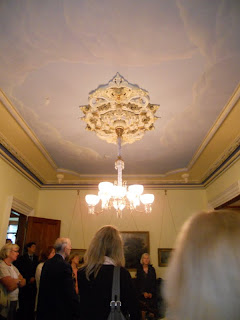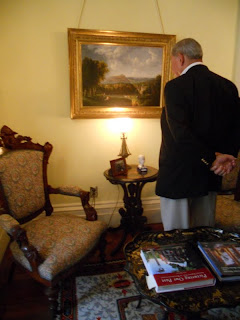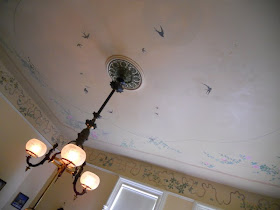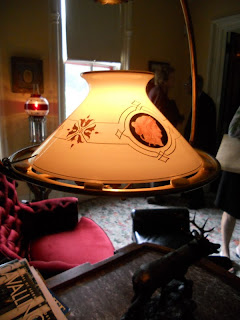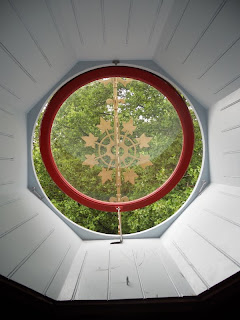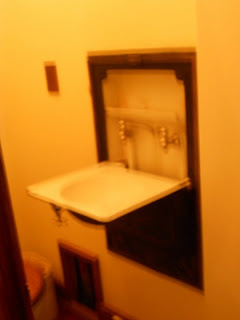The adventures continue! I took the day off work today to go on a tour of the Octagon House in Irvington, New York, and though I very much missed work (and I say that with every atom of sincerity and honesty in my body), I'm quite glad I went. It is an absolutely beautiful building, and I have a huge amount of respect for Joseph Lombardi, the preservation architect who has spend the last 30-odd years restoring it. He actually gave the tour today, and... well. It was as good as you would expect it to be, considering the amount of knowledge he has on the house (not to mention the amount of passion he appears to have for it). In addition, it's simply very comforting to see somebody doing such a wonderful job at a time when these older buildings are very much in danger.
All of that being said...
Of course, the Octagon House is in the shape of an octagon. This style of house was quite popular in the 1850s, though apparently this popularity was brief. If I remember correctly, this house is the only domed octagon house in the United States-- and the dome wasn't even constructed properly! One of the things Mr. Lombardi had to do upon taking responsibility for the house was to prevent the dome from coming apart and causing the collapse of the rest of the building.
The house was begun in the 1860s, but it was not completed to its current appearance until 1872 (I must take a moment to brag a bit here: I guessed the date before he had even said anything. Well. Not precisely. But I think "early 1870s" counts, no?)
Don't mind me in that picture there. Anyway. It can be placed quite firmly under the category of "Victorian," in terms of both date and style. Having spent quite some time last semester reading and re-reading and discussing Kenneth L. Ames' "Death in the Dining Room and Other Tales of Victorian Culture," I seem to have grown a somewhat unhealthy interest in Victorian furniture. In any case, this isn't the original hall stand, but I was so happy to find a perfect example of a piece of furniture that I've read entire chapters about that I felt I needed to commemorate it.
(Just in case anybody is actually interested in why hall stands are important... I'll give a very quick run-through. They usually have a few main components: the mirror, the umbrella stand and assortment of hooks for coats and hats, etc, and the calling-card tray. Calling cards: a very important ritual in a culture obsessed with it. Insert lecture on Industrial Revolution and need to create tradition in a time of rapid and even violent change here. The mirror: obviously useful if one wants to see one's self. Also useful in amplification of light. Also used to show off wealth (the ornate carving found in many hall stands would also contribute to this). Umbrella stand/coat rack: obviously useful. Also helpful to guests, who would be able to tell who was or was not home based on whose coat/hat/umbrella was hanging up.)
...moving on!
The house has a lot of Neo-Roman motifs, from the dome itself (a Roman innovation), to the neo-classical sculptures found in areas of the house, to the images of chariots and Roman centurions found practically everywhere. More on that later.
This is the parlor...
...which has a really lovely ceiling...
...a lot of Hudson River paintings...
...and a tea set that, much like every other tea set I ever set eyes upon, I want.
...and some more Neo-Roman motifs! Difficult to see in this picture, of course, because I am physically incapable of taking proper photographs, but the napkin ring is decorated with the image of a Roman soldier (helmet and all). The flatware is original.
Okay. Really interesting Victorian furniture. One of Ames' observations about Victorian breakfronts and other dining room furniture is that it tends to be a bit... morbid? I'm sure there are those who would disagree with that characterization, but there is a tendency to decorate with images or carvings of dead animals (aka: food). 'Of course,' I thought to myself for months, 'it's easy for him to say that: he gets to pick and choose what evidence he wants to show us in this book here...' It's not as if I didn't believe him... but still. Nice to have some more evidence.
The Dining Room.
Doorknob with... guess what?
Another lovely ceiling!
At this point, I'll stop pointing out the Neo-Roman motifs.
I'll start pointing out the Eastern Elk motifs instead. They're everywhere, except in real life. Unfortunately, they're near extinction. I would not be surprised if there were more Eastern Elk images in this house than there are currently living ones on the planet at this moment.
Some very beautifully painted furniture...
At this point, we are in what Mr. Lombardi called the "Ladies' Gymnasium." This sink was meant to be used somewhere in the process of watercolor painting, I was told.
This is the "Curiosities Room," or the "Butterfly Room" (so named for clear reasons).
This is a table decorated with butterfly wings. Real ones. In much the same way that I would feel odd about wearing fur, I'm not sure how I feel about this table. Except that I think it's very pretty. If not a bit odd.
And finally, we're up in the dome! Supposedly this area was used as dancing space. I did not test that claim.
It's a very beautiful room, with octagonal windows...
... and a staircase up to the observatory.
Heading back down...
...again, a bad picture, but I thought this was a very interesting idea... this is what I've now dubbed a Murphy Sink. It's a sink... that folds into the wall. There is no drain, but when you fold it back, the water flows down a gap in the back one cannot quite see in this photo... anyway.
Back in the entrance hall. The walls had to be painted over, but Mr. Lombardi left a small rectangle of the original paint uncovered.
Out on the porch (which surrounds the entire house).
Gas lamps!
Well... not much else to say about that. The website can be found here (along with far better photos): http://www.josephpelllombardi.com/5homes/newoctagon.html.
More to come at some point. Until then, my love to all!
Tasha




